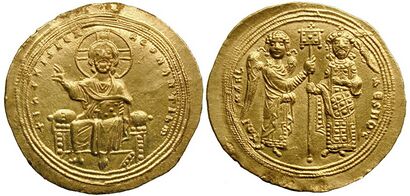1041
| قرن: | قرن 0 - قرن 1 - قرن 2 |
| العقد: | عقد -20 عقد -10 0 - عقد 10 - عقد 20 عقد 30 عقد 40
|
| سنة: | 7 8 9 - 10 - 11 12 13 |
| التحويل من ميلادي إلى هجري |
| تحويل 1-1-1041م الى هجري (وصلة خارجية) |
| تحويل 31-12-1041م الى هجري (وصلة خارجية) |
| ابحث في الموسوعة عن مواضيع متعلقة بسنة 1041 |
تحويل 1-1-1041م الى هجري (وصلة خارجية) | تحويل 31-12-1041م الى هجري (وصلة خارجية) | ابحث في الموسوعة عن مواضيع متعلقة بسنة 1041
| ألفية: | الألفية 2 |
|---|---|
| قرون: | القرن 10 – القرن 11 – القرن 12 |
| عقود: | عقد 1010 عقد 1020 عقد 1030 – عقد 1040 – عقد 1050 عقد 1060 عقد 1070 |
| سنين: | 1038 1039 1040 – 1041 – 1042 1043 1044 |

Michael V Kalaphates (c. 1015–1042)
| 1041 حسب الموضوع | |
| قوائم الزعماء | |
| زعماء الدول | |
| تصنيفا المواليد والوفيات | |
| المواليد – الوفيات | |
| تصنيفا التأسيسات والانحلالات | |
| التأسيسات – الانحلالات | |
| التقويم الگريگوري | 1041 MXLI |
| آب أوربه كونديتا | 1794 |
| التقويم الأرمني | 490 ԹՎ ՆՂ |
| التقويم الآشوري | 5791 |
| التقويم البهائي | −803 – −802 |
| التقويم البنغالي | 448 |
| التقويم الأمازيغي | 1991 |
| سنة العهد الإنگليزي | N/A |
| التقويم البوذي | 1585 |
| التقويم البورمي | 403 |
| التقويم البيزنطي | 6549–6550 |
| التقويم الصيني | 庚辰年 (المعدن التنين) 3737 أو 3677 — إلى — 辛巳年 (المعدن الثعبان) 3738 أو 3678 |
| التقويم القبطي | 757–758 |
| التقويم الديسكوردي | 2207 |
| التقويم الإثيوپي | 1033–1034 |
| التقويم العبري | 4801–4802 |
| التقاويم الهندوسية | |
| - ڤيكرام سامڤات | 1097–1098 |
| - شاكا سامڤات | 963–964 |
| - كالي يوگا | 4142–4143 |
| تقويم الهولوسين | 11041 |
| تقويم الإگبو | 41–42 |
| التقويم الإيراني | 419–420 |
| التقويم الهجري | 432–433 |
| التقويم الياباني | Chōkyū 2 (長久2年) |
| تقويم جوچى | N/A |
| التقويم اليوليوسي | 1041 MXLI |
| التقويم الكوري | 3374 |
| تقويم مينگوو | 871 قبل جمهورية الصين 民前871年 |
| التقويم الشمسي التايلندي | 1584 |
Year 1041 (MXLI) was a common year starting on Thursday of the Julian calendar.
أحداث
By place
Byzantine Empire
- December 10 – Emperor Michael IV the Paphlagonian dies after a 6-year reign. His wife, Empress Zoë, elevates (on the advice of her lover John the Orphanotrophos) her adoptive son to the throne of the Byzantine Empire, as Michael V Kalaphates. Shortly after, Michael comes into conflict with his uncle John, and banishes him to a monastery.
Europe
- March 17 – Battle of Olivento: Norman troops and their Lombard allies, led by William Iron Arm, are victorious against the Byzantines at the feet of the Monte Vulture, near the River Olivento in Apulia.
- May 4 – Battle of Montemaggiore: Lombard-Norman rebel forces, led by William, are again victorious, and defeat a Byzantine army (18,000 men) on the hill of Montemaggiore, near the River Ofanto.
- September 3 – Battle of Montepeloso: Lombard-Norman rebel forces, led by William, defeat the Byzantines at Montepeloso. During the battle, Boioannes, governor of the Catepanate of Italy, is captured.
- Winter – Battle of Ostrovo: The Byzantines, with the help of the Varangian Guard, led by Harald Hardrada (future king of Norway), defeat the Bulgarian troops, near Lake Ostrovo in Greece.
England
- King Harthacnut invites his half-brother Edward the Confessor to return to England from exile in Normandy as his heir as king of England,[1] with the support of Godwin, Earl of Wessex.[2]
- The city of Worcester rebels against the naval taxes of Harthacnut. He reduces the navy from 60 to 32 ships.
Africa
- The Zirid dynasty rejects Shi'ite obedience and Fatimid domination, and recognizes the Abbasids as their overlords.[3]
Asia
- At about this time, the number of enlisted soldiers in the Song dynasty Chinese military reaches well over 1,250,000 troops, an increase since 1022, when there were a million soldiers.
مواليد
- Ōe no Masafusa, Japanese poet (d. 1111)
- Raymond IV, Count of Toulouse (Raymond of Saint-Gilles), French nobleman (d. 1105) (approximate date)
وفيات
- February 4 – Fujiwara no Kintō, Japanese poet (b. 966)
- December 10 – Michael IV the Paphlagonian, Byzantine emperor (b. 1010)
- Adolf II of Lotharingia, German nobleman (b. 1002)
- Akazome Emon, Japanese waka poet (approximate date)
- Eadwulf IV of Bamburgh, Northumbrian ruler
- Edmund of Durham (or Eadmund), English bishop
- Gangeyadeva, Indian ruler of the Kalachuris of Tripuri
- Mac Beathaidh mac Ainmire, Irish poet and Chief Ollam
- Muhammad of Ghazni, sultan of the Ghaznavids (b. 998)
- Muhammad ibn Rustam Dushmanziyar, Buyid emir
- Peter Delyan, Bulgarian rebel leader and ruler (tsar)
- Sampiro, Spanish bishop, politician and intellectual
- Tancred of Hauteville, Norman nobleman (b. 980)
- Vikramabahu, Prince of Ruhuna (or Kassapa), ruler of Sri Lanka (b. 1017)
References
- ^ Lawson, M. K. (2004-09-23). "Harthcnut". قاموس أكسفورد للسيَر الوطنية (online ed.). Oxford University Press. doi:10.1093/ref:odnb/12252. (Subscription or UK public library membership مطلوبة.)
- ^ Quadripartitus.
- ^ Gilbert Meynier (2010). L'Algérie cœur du Maghreb classique. De l'ouverture islamo-arabe au repli (658-1518). Paris: La Découverte; p.50.
This article may include material from Wikimedia licensed under CC BY-SA 4.0. Please comply with the license terms.